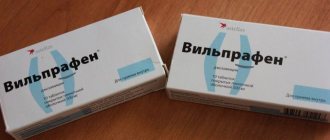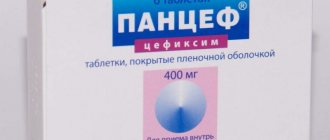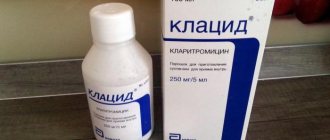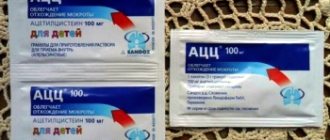Indications for use
Vilprafen is a suspension for children that can be used for the following indications:
- infectious diseases of the throat, nose and nasopharyngeal area;
- diseases of the gastrointestinal tract associated with Helicobacter pylori;
- infectious lesions of the oral cavity, eyes and reproductive system;
- infections in the lungs, trachea, skin and mucous membranes.
In particular, these include many pathologies:
- tonsillitis, otitis, pharyngitis, sinusitis, scarlet fever;
- bronchitis in the acute stage, pneumonia, whooping cough, psittacosis;
- furunculosis, abscess, anthrax, erysipelas of the skin;
- blepharitis, syphilis, cervicitis, lymphogranuloma, urethritis, gastric ulcer.
When combined with local application of drugs, the duration of treatment is significantly reduced without recurrent infection.
Instructions for use of Vilprafen
During clinical studies, significant drug saturation was reliably detected in lung tissue, lymphatic pharyngeal ring, salivary fluid, tears and sweat exudate.
The active substance penetrates and accumulates in the adenoids, structures of the middle ear, sinuses, prostate gland, and skeletal bone tissue. Not significantly detected in liquor.
Indications and contraindications for use
The main indications for use are determined depending on the distribution of josamycin metabolites in the body. The manufacturer indicates in the instructions the following diseases of a microbiological nature:
- in pediatrics - damage to the respiratory tract at all levels and ENT organs - tonsillitis, pharyngolaryngitis, tonsillitis, sinusitis, otitis media, bronchitis, pneumonia (including atypical), psittacosis, diphtheria, scarlet fever, whooping cough;
- in dentistry – infectious gingivitis, stomatitis, periodontal infections;
- in the ophthalmological field - purulent blepharitis, dacryocystitis;
- dermatovenerological infections - pyoderma, furunculosis, carbunculosis, anthrax, erysipelas, purulent acne, gonorrhea, syphilis, bacterial prostatitis, urethritis, chlamydial, mycoplasma (including ureaplasma) and mixed diseases of an infectious nature.
The main contraindication to the use of Vilprafen is the previously known increased reaction to a number of macrolides and a pronounced malfunction of the liver. Treatment of premature babies with the drug is strictly prohibited.
Method of administration and dosage of the medicine
Vilprafen should be taken strictly as prescribed by your doctor. The tablets are taken orally, without chewing, with a small amount of water.
Vilprafen Solutab (water-soluble form) can also be taken whole, or diluted in 20 ml of water. The resulting suspension must be carefully mixed before use until smooth.
For adult patients and children over 14 years of age, the recommended daily dosage of the drug is 1000–2000 mg, the maximum permissible daily dose can be increased to 3 g. This dose should be divided into 2-3 doses.
Vilprafen in the form of a suspension can also be given to children under 14 years of age, but under constant monitoring of liver function. In this case, the amount of the drug is calculated strictly individually, based on a daily dose of 40-50 mg per kg of the child’s body weight. The medicine must be distributed 2-3 times.
In Russia, the use of josamycin during pregnancy and breastfeeding is possible only if the doctor clearly assesses the benefit/risk ratio. WHO recommends treating chlamydial colpitis in pregnant women exclusively with drugs containing josamycin.
Side effects and overdose
Macrolide antibiotics have a high level of safety in relation to all groups of antibacterial agents.
In clinical trials, adverse reactions were quite rare. When treated with Vilprafen, undesirable effects are possible when damaged:
- intestinal tube - migrating abdominal pain or discomfort, loss of appetite, nausea, vomiting, upset stool;
- liver - in some cases there is an increase in transaminase activity in the blood, cholestasis, icterus of the skin and mucous membranes;
- brain and central nervous system – transient hearing loss, dose dependent;
- local allergic manifestations (redness, rashes).
Information on specific symptoms of overdose and poisoning with Vilprafen was not obtained during the trials. The occurrence and intensification of these undesirable effects is expected.
Drug interactions with other medications
Drug interactions of Vilprofen with medications:
- cyclosporine antibiotics – the concentration of cyclosporins in the blood may rise to the level of nephrotoxicity;
- other antibiotics – a decrease in the bactericidal effect of penicillins and cephalosporins cannot be ruled out;
- antihistamines (Terfenadine, Astemizole) – it is possible to inhibit the elimination of Terfenadine and Astemizole, which can become an impetus for the occurrence of arrhythmia;
- ergot alkaloids (Ergotamine) – in isolated cases, vasoconstriction may occur and intensify;
- cardiac glycosides (Digoxin) – there is an increase in the level of the drug in the blood plasma;
- xanthines (Theophylline) – probably inhibits the elimination of Theophylline, which can lead to intoxication syndrome;
- hormonal oral contraceptives – decreased contraceptive effect (rather rare).
Compound
The drug contains the main active ingredient in various dosages in combination with auxiliary components.
| Active substance | Dosage, mg/ml of finished suspension | ||
| 125/5 | 250/5 | 500/5 | |
| Contents in 1 bottle | |||
| Josamycin | 15 g | 15 g | 20 g |
| Excipients, mg | |||
| Na Citrate | 112,5 | ||
| Methylparaben | 79,5 | ||
| Propylparaben | 10,5 | ||
| Simethicone | 75 | ||
| Hypromelose | 180 | 225 | 300 |
| Fragrance | 37,5 | 50 | |
| Carmellose Na | 570 | 1200 | 600 |
| Sugar 3% | 10108 | 7848 | 10200,5 |
| Mannitol | 2250 | ||
Josamycin is a natural macrolide antibiotic produced by the actinomycete Streptomyces narbonensis. Since 2012, it has been included in the list of vital and essential medicines.
Excipients increase the pharmacological activity of the active ingredient, increase the shelf life of the diluted suspension and provide the required consistency of the finished product.
Antibiotic Vilprafen
Vilprafen
is
a broad-spectrum
antibiotic macrolide
.
Its active ingredient is josamycin
.
In therapeutic doses, the drug acts on pathogenic microorganisms bacteriostatically (inhibits their vital activity), and in high concentrations its effect becomes bactericidal (destructive for bacteria).
The drug is effective against many microorganisms - gram-negative (meningococci, gonococci, Haemophilus influenzae, Helicobacter pylori, etc.) and gram-positive (staphylococci, streptococci, pneumococci, corynebacterium diphtheria, etc.). It is also prescribed to combat intracellular microorganisms (chlamydia, mycoplasma, ureaplasma, etc.), as well as some anaerobic bacteria (peptococci, peptostreptococci, bacteroides and clostridia).
Vilprafen is quickly absorbed from the digestive tract. Within an hour its maximum concentration in the blood is reached. At the same time, Vilprafen has a long-term therapeutic effect.
The drug crosses the placental barrier and can be excreted in breast milk.
The medicine is inactive against enterobacteriaceae, and therefore has virtually no effect on the intestinal microflora.
80% of Vilprafen is excreted in bile, 20% in urine.
In what form is it produced?
The drug is available in powder form for self-preparation of a homogeneous suspension. The sizes of individual particles of the active substance provide a long-lasting therapeutic effect, which allows you to reduce the frequency of administration during the day.
Separate dosages provide convenient dosing for children of different ages and should be used in accordance with the recommendations of the instructions.
Average prices for Vilprafen granules:
- 125 mg/5 ml – from 400 rubles;
- 250 mg/5 ml – from 430 rubles;
- 500 mg/5 ml – from 500 rub.
The cost depends on the type of pharmacy chain and the distance of the pharmacy from the central areas of the city. If necessary, the drug can be ordered through online services for delivery to a specific pharmacy at a lower price.
Release form and composition
Vilprafen has different release forms; for children it is used:
- Tablets that have the ability to dissolve in liquid (the result of this process is a pinkish liquid interspersed with the drug and a pleasant strawberry aroma). For adult patients, a drug with a special shell is used, which is not subject to the harmful effects of stomach hydrochloric acid. The tablets have double-sided marks, are white in color and have a somewhat oblong, convex shape. Each pack contains 1 blister containing 10 tablets.
- In the form of a suspension, which is a powder that requires the addition of a certain amount of water. The suspension has a whitish color, sweet taste and pleasant fruity aroma.
The main component of Vilprafen is a substance called josamycin. This antimicrobial component is contained in an amount of 500 mg per tablet. In addition to the main one, the medicine contains a number of auxiliary elements: polysorbate, methylcellulose, talc, aluminum hydroxide and more.
Pharmacodynamics
Vilprafen is a suspension for children that acts bacteriostatically:
- inhibits protein formation;
- prevents DNA dynamics;
- inhibits bacterial metabolism.
As a result, the processes of their life, development and reproduction stop. In combination with a person’s own immunity, it is possible to completely suppress the infection in a relatively short time.
When a high concentration is created in the focus, a bactericidal effect appears. In this case, josamycin begins to directly destroy bacteria. By binding to the 50S subunit of the ribosomal membrane, it prevents the attachment of transfer RNA and the transfer of peptides from the A-center, thereby suppressing protein synthesis in bacterial cell walls.
The spectrum of pharmacological activity includes several types of bacteria:
- coccobacilli of the genus Bordetella;
- anthrax pathogens;
- anaerobic actinomycetes;
- Haemophilus influenzae;
- corynobacteria;
- streptococci;
- mycoplasma;
- legionella;
- Treponema;
- gonococci;
- rickettsia;
- chlamydia.
The drug is also active against some fungi and anaerobes of other classes. Efficiency may decrease slightly due to the development of resistance in microorganisms.
Indications for use of Vilprafen
The instructions included with it do not recommend self-treatment with Vilprafen. Parents should consult a doctor and understand the intricacies of using the drug.
Indications for use, the instructions for Vilprafen disclose a number of pathologies that are often found in children:
- infectious diseases occurring with inflammatory processes;
- infections of the ENT organs and upper respiratory tract (tonsillitis, otitis media, sinusitis, tonsillitis, laryngitis, pharyngitis);
- lower respiratory tract infections (whooping cough, pneumonia, bronchopneumonia, acute bronchitis);
- infections of the skin and soft tissues (phlegmon, pyoderma, lymphadenitis, furunculosis, erysipelas);
- infection of the genitourinary system (pyelonephritis, mycoplasmosis, epididymitis, ureaplasma, urethritis, chlamydia);
- infectious lesions of the oral cavity (stomatitis, gingivitis, alveolitis, periodontal disease).
Pharmacokinetics
Josamycin after internal administration is absorbed in the intestine in a short time and in full. The maximum concentration in the blood serum is reached after 1-4 hours. About 10% of the dose taken is bound to plasma proteins. The highest amounts are found in lung tissue, tonsils, sweat, tears and salivary fluid.
The substance undergoes biological transformation in the liver tissues to less active forms, which are then excreted from the body with bile. Excretion of the drug in urine does not exceed 20%.
Operating principle
Vilprafen is a tablet or suspension used for oral use to eliminate the source of bacterial infection from the body. The active substance, which is josamycin, allows you to quickly and effectively cope with a number of pathogenic microorganisms. The components of the antibiotic have a detrimental effect on the provocateurs of the infectious process, causing the cessation of bacterial protein synthesis processes.
Josamycin has the ability to accumulate in tissues affected by bacterial exposure, which increases the duration and extent of the antibacterial effect.
The medication is highly effective against:
- gram-positive bacteria (pneumococci, staphylococci, streptococci);
- gram-negative bacteria (Helicobacter pylori);
- ureaplasma, chlamydia.
The drug can even be used for complex therapy of various pathologies affecting gynecology and venereology.
After oral administration of an antibiotic, the active components of the drug are quickly absorbed by the tissues of the digestive tract, penetrating into the systemic bloodstream. The maximum amount of josamycin can be observed after 2-3 hours, in biological fluids (saliva, urine, bile, sweat, vaginal discharge, tears, semen).
Use for children under 18 years of age
Together with the bottle, the kit includes a special measuring syringe for precise dosing of the finished suspension. Before taking the required dose, you should always shake the drug thoroughly to evenly distribute the active particles of the drug throughout the entire volume.
After this, you need to take a single dose with a syringe and carefully inject the drug between the cheek and tongue, not too close to the throat. Then offer the child water or another neutral drink.
The recommended amount of josamycin is 50 mg/kg body weight.
It should be divided into 2 equal doses:
- 25 mg/kg in the morning;
- 25 mg/kg after 12 hours.
The maximum single dose should not exceed 1 kg, despite the patient's weight being greater than the proportion given. The duration of therapy is determined by the observing specialist and depends on the symptoms, severity of the disease and the child’s body’s response to the antibiotic. The average duration of treatment can reach 5-7 days.
If you accidentally miss the next dose, you should not double the amount of suspension.
Directions for use: special instructions
Vilprafen for children is prescribed after the baby reaches a body weight of 10 kilograms. However, some dosage forms of the drug do not allow its use until the child is two or three years old.
Not all children, even by the age of 6, can cope with swallowing quite large tablets. This is where Vilprafen dispersible tablets come to the rescue, which can be placed in a small amount of water, until they are completely dissolved and given to the child to drink.
We recommend reading: Nonproductive cough: why it appears and how to treat the symptom
Despite the presence of a larger amount of active substance in this dosage form (the dose of josamycin is 1000 mg), they are allowed to be divided into the required number of parts (as recommended by the doctor). Every baby can swallow such a suspension, even those who have recently reached the age of two.
Each antibiotic can have a negative effect on the functioning of the digestive tract, due to the fact that along with pathogenic bacteria, beneficial bacteria are also destroyed. In order to avoid serious problems with digestion and stool in an infant, Vilprafen is often prescribed simultaneously with antihistamines.
Features of using Vilprafen:
- tablets are taken orally (when using the Solutab form, pre-dissolve in pre-boiled or cooled water, ensuring that the tablet turns into a homogeneous suspension);
- It is forbidden to chew tablets encased in a hard shell (it is necessary to protect the active substance from the harmful effects of gastric juice);
- The drug should be washed down with a sufficient amount of clean water;
- You should take the tablets after a meal or 30 minutes before it.
Specific doses of the drug are determined only by the specialist who prescribed this antibiotic. He will also determine the duration of treatment therapy, based on the severity of the disease, the patient’s health status, and the presence or absence of chronic pathologies.
Contraindications
Vilprafen is a suspension for children that should not be used for medicinal purposes if there are the following contraindications:
- hypersensitivity to the action of josamycin or other macrolide antibiotics;
- combination with ergotamine, cisapride, pimozide, ivabradine, colchicine;
- with significant pathologies of liver function;
- lack of sucrase or isomaltase.
In patients with insufficient renal function, treatment should be prescribed based on the results of creatinine clearance tests.
Price, alternative drugs
Vilprafen is sold only with a doctor's prescription. Tablets (500 mg) cost an average of 530 rubles, and pills (1000 mg) cost 650 rubles. There are no structural analogues of Vilprafen with josamycin.
In case of hypersensitivity to the active component, the drug is replaced with other medications with similar properties:
- Flemoxin Solutab is an antibacterial agent from the penicillin group. Soluble tablets are diluted with water to prepare fruit syrup. Children take this medicine from any age to treat otitis, inflammation of the bronchi, furunculosis, etc.
- Augmentin with clavulanic acid is also suitable for newborns. The suspension is prescribed for the treatment of whooping cough, pneumonia, tonsillitis, etc.
- Zinat is an antibacterial drug that is a representative of cephalosporins. The solution is suitable for patients from 3 months.
- Azithromycin-based Azitrox is available in powder and capsules. The suspension is used to treat children from 6 months.
- Macropen with midecamycin is available in the form of granules for the preparation of suspensions and tablets. The first dosage form is allowed to be taken by newborns.
- Klacid based on clarithromycin in the form of a suspension is suitable for patients over 3 years of age.
Thus, Vilprafen is an effective antibiotic that helps cure a large number of bacterial infections. Before giving the drug to your child, visit a pediatrician who will select the appropriate form of medication. Parents must follow the doctor's recommendations regarding the use of the medication. If negative effects occur in your baby, stop taking Vilprofen and, together with your doctor, select a similar drug.
vskormi.ru
Read further:
Vilprafen during pregnancy - instructions for use in the 1st, 2nd, 3rd trimesters
Augmentin for children - instructions for use of suspension (125, 200 and 400 mg), dosage of tablets
Amoxicillin for children - instructions for use of suspension (125 and 250 mg), syrup and tablets
Nifuroxazide: suspension - instructions for use for children, use of tablets
Vermox for children - instructions for use of suspension and tablets for the prevention of worms
Amoxiclav suspension 250 and 125 mg - instructions for use for children, syrup dosage
Overdose
If the dose is calculated incorrectly, a significant overdose of Vilprafen is possible, in particular in small children with low weight.
Symptoms:
- bowel disorders;
- severe nausea;
- gagging;
- hearing loss.
There are few reports of overdose in medicine. Vilprafen, despite the sweeteners, has a rather unpleasant taste, so the risk of significantly exceeding the dose is unlikely.
Otherwise, it is recommended to immediately take adsorbents such as Polysorb or Enterosgel in maximum quantities to quickly bind and remove the drug from the body. Severe conditions require emergency medical attention.
Soluble tablets Vilprafen Solutab
Average price: 650 rub.
These dissolvable tablets are often prescribed to children when the suspension needs to be replaced.
Vilprafen Solutab – soluble tablets:
- Vilprafen Solutab 1000 – white or yellowish oblong, with the designation “IOSA” and “1000” on opposite sides, a dash on one side
- They have a sweetish taste with a fruity aroma
- 5 tablets each in 2 blisters in a cardboard package.
Vilprafen Solutab tablets (soluble) contain:
- Josamycin propionate 1067, 66 mg (corresponds to 1000 mg josamycin);
- Cellulose, hyprolose, sodium docusate, aspartame, silicon dioxide, strawberry flavor, magnesium stearate.
Side effects
Even treatment at recommended doses is in most cases accompanied by side effects:
- on the skin - rashes, erythema, skin pathologies, acute or toxic epidermal necrolysis;
- from the gastrointestinal tract - nausea, vomiting, stool liquefaction, stool consolidation;
- from the liver - increased activity of liver transaminases, hepatitis;
- on the part of the immune system - allergies such as rashes, Quincke's edema;
- others - purpura, vasculitis, metabolic disorders, anorexia.
If you notice any symptoms, you should seek medical help.
How does the medicine work?
In accordance with the instructions, the antibacterial effect of taking Vilprafen and Vilprafen Solutab is aimed at inhibiting the reproduction of microbes, which manifests itself in the form of a bacteriostatic effect. In order to exert a bactericidal effect (death of pathogenic microorganisms), a maximum concentration of the active substance is required directly in the inflamed area.
After oral administration, the drug is quickly and fully absorbed; food does not actually reduce the bioavailability of the drug. During preclinical tests on pregnant animals, penetration of the active component into breast milk and a high level of permeability of the hemato-placental threshold were noted.
Drug interactions
Vilprafen is a suspension for children, the combined use of which with certain drugs can lead to serious consequences:
- ergotamine, dihydroergotamine - the likelihood of sudden tension of the vascular walls with the possibility of necrotic changes in the limbs;
- cisapride, pimozide - the risk of heart rhythm disturbances that threaten the life of the affected person;
- ivabradine – after interaction with josamycin, the content of ivabradine and the risk of side effects increases;
- colchicine – the likelihood of developing side effects that threaten the life of a sick person increases.
Less dangerous, but also undesirable, include interactions with the following drugs:
- amitriptyline;
- bromocriptine;
- carbamazepine;
- cyclosporine;
- disopyramide;
- halofantrine;
- sildenafil;
- caberboline;
- terfenadine;
- tacrolimus;
- theophylline;
- triazolam;
- astemizole;
- digoxin;
- ebastine.
Simultaneous combination with anticoagulant drugs of indirect influence increases the risk of serious bleeding.
How much and how to give
Features of the use of Vilprafen in children are reflected in the instructions that are attached to each dosage form, whether dispersible tablets or suspension.
Antibiotic dosage:
- children weighing more than 40 kg (over 14 years of age) can take 1-2 tablets of the drug twice a day. If necessary, the dose can be increased to two tablets per dose;
- infants weighing more than 10 kg (up to 14 years) take a tablet three times a day, taking into account time intervals of 8 hours.
The duration of therapy is determined by the attending physician on an individual basis. The Rhône can vary from 5 days to 21 days. Unauthorized reduction or extension of this period is prohibited. In the first case, the bacteria may not be completely destroyed, which will lead to the development of their resistance and the appearance of superinfection. In the second case, symptoms of severe intoxication of the body may appear.
If you miss the next dose of a pill, it should be taken as soon as the patient remembers. If you remember about the forgotten pill by the time it is time to take the next dose of the drug, it is forbidden to drink double the dose.
Analogs
The main analogues of Vilprafen include Sumamed, Azitrox, Zitrolide and other drugs, the active substance of which is azithromycin, a macrolide antibiotic, the first representative of the azalide subclass.
Another common analogue is clarithromycin. Preparations in the form of suspensions are also created on its basis. One of the most common in pharmacies is Klacid. Its effect on pathogens is somewhat weaker and the therapeutic effect develops more slowly. Therefore, only a specialist should recommend a suitable remedy.
Azithromycin
Pharmacodynamics - the substance has a wide spectrum of antibacterial activity. Azithromycin stops the processes of vital activity and reproduction of bacteria, inhibiting peptide translocase at the stage of transmission to other cells and suppressing the processes of protein synthesis. In high doses, it destroys extracellular and intracellular bacteria.
After internal administration, azithromycin is quickly absorbed and distributed throughout all tissues of the body. Bioavailability reaches 37%. The indicator is associated with the effect of primary passage through the liver. The highest concentration in the blood serum is reached after 2-3 hours and is about 0.4 mg/l.
Pharmacokinetics – azithromycin penetrates well through cell membranes, and therefore the drug is highly effective against infections localized in their internal cavities. Transport is carried out by phagocytes to places where microorganisms spread.
The concentration in soft tissues reaches 10-50 times higher levels than in blood plasma, and is 24-34% higher at the site of infection than in surrounding tissues. In the liver, azithromycin undergoes secondary demethylation, after which the substance loses its pharmacological activity.
The main part of azithromycin is excreted in its original form:
- through the intestines - from 50%;
- kidneys – about 6%.
The half-life reaches 50 hours. Therapeutic concentrations after the last dose taken remain at a sufficient level for up to 1 week. Then the process of complete elimination from the body begins. Sumamed and other drugs with azithromycin can be used for infections of all parts of the respiratory tract and many other diseases.
Due to the long elimination time and gradual accumulation in the body, it is recommended to take the drug no more than once a day.
An important condition for complete absorption is not to combine the drug with food:
- You can take medications with azithromycin either 1 hour before meals or 2 hours later;
- The drug should be taken with a sufficient amount of water of at least 100 ml.
For accurate dosing, use the following ratios:
- the calculation must be made based on the child’s body weight;
- for 1 kg of weight it is recommended to take 10 mg 1 time per day for 3 days in a row.
In severe forms of the disease, the duration of treatment can be increased to 6 days. Longer use is not recommended due to an increased risk of severe side effects.
The following states are characterized by relative frequency:
- candidiasis of the mucous membranes;
- respiratory symptoms;
- bacterial infections;
- appetite disorders;
- exacerbation of gastritis;
- thrombocytopenia;
- leukopenia, etc.
It is very common to experience sharp abdominal pain on average 30 minutes after administration. This applies to variants of the norm. Particular severity of pain is observed after 1-2 doses. Subsequently, the symptom weakens. As a rule, azithromycin significantly dilutes the stool, and after the next visit to the toilet the pain stops.
Clarithromycin
Klacid is a medicine containing clarithromycin, intended for children, available in the form of a powder mixture for the preparation of a suspension. 1 bottle contains 70.7 g of active substance, or 125 mg/5 ml in a solution ready for treatment. Pharmacologically it is a macrolide. The antibiotic blocks protein production in bacteria that are sensitive to it.
Preparation of the suspension - carefully add clean water to the bottle until the risk with periodic shaking. The total volume of the finished product is 100 ml. Room conditions are suitable for storing the suspension. Shelf life – no more than 14 days. Residues of the drug must be disposed of with household waste.
Dosages:
- The recommended daily dose for children is 7.5 mg/kg body weight 2 times a day;
- the highest dose should not be more than 0.5 g 2 times a day.
Single dose to be taken 2 times a day:
- 8-11 kg – 2.5 ml;
- 12-19 kg – 5 ml;
- 20-29 kg – 7.5 ml;
- 30-40 kg – 10 ml.
For children weighing less than 8 kg, the calculation is made based on the proportion of 7.5 mg/kg. The resulting volume of the drug should also be taken 2 times a day. The usual duration of treatment is no more than 10 days. It depends on the child’s well-being and the type of infection. When creatinine clearance is less than 30 ml/min, it is recommended to reduce the volume of a single dose by 2 times. The total duration of treatment is up to 2 weeks.
Vilprafen is an effective drug for treating children from a variety of infections and other pathologies. If necessary, it can be replaced with another drug in the form of a suspension from the macrolide group. It is only important to follow the basic recommendations in order to achieve maximum efficiency in the shortest possible time.
Vilprafen 500mg/5ml 20g granules for suspension for oral administration
pharmachologic effect
Antibiotic, macrolide.
Composition and release form Vilprafen 500 mg/5 ml 20 g granules for the preparation of suspension for oral administration
Granules for preparing a suspension - 1 vial:
- Active ingredients: josamycin propionate - 6.307 g;
- Excipients: sodium citrate - 0.1125 g, methyl parahydroxybenzoate - 0.0795 g, propyl parahydroxybenzoate - 0.0105 g, simethicone - 0.075 g, hyprolose - 0.3 g, Avicel RC-591 [microcrystalline cellulose, sodium carmellose] - 0.6 g, strawberry flavor - 0.05 g, betacarotene - 0.015 g, sucrose starch powder 3% - 10.2005 g, mannitol - 2.25 g.
5 ml of the finished suspension contains 500 mg of josamycin.
15 g - Colorless glass bottles with a capacity of 100 ml (1) (complete with dosage syringe and syringe holder) - cardboard packs.
Description of the dosage form
Granules for the preparation of a suspension for oral administration are yellow, with the smell of strawberries; after dissolving in water, a yellow suspension with the smell of strawberries is formed.
Characteristic
Antibiotic of the macrolide group, produced by Streptomyces narbonensis var. Josamyceticus.
Directions for use and doses
When taken orally by adults and children over 14 years of age - 1-2 g/day in 2-3 divided doses. Children under 14 years of age - 30-50 mg/kg/day in 3 divided doses. The duration of treatment depends on the indications for use.
Pharmacodynamics
Antibiotic of the macrolide group. It has a bacteriostatic effect due to inhibition of protein synthesis by bacteria. When high concentrations are created at the site of inflammation, it has a bactericidal effect.
Highly active against intracellular microorganisms: Chlamydia trachomatis and Chlamydia pneumonuae, Mycoplasma pneumoniae, Mycoplasma hominis, Ureaplasma urealyticum, Legionella pneumophila; against gram-positive aerobic bacteria: Staphylococcus aureus, Streptococcus pyogenes and Streptococcus pneumoniae (pneumococcus), Corynebacterium diphtheriae; gram-negative aerobic bacteria: Neisseria meningitidis, Neisseria gonorrhoeae, Haemophilus influenzae, Bordetella pertussis; against some anaerobic bacteria: Peptococcus, Peptostreptococcus, Clostridium perfringens.
Josamycin is also active against Treponema pallidum.
Pharmacokinetics
After oral administration, josamycin is rapidly absorbed from the gastrointestinal tract. Cmax is achieved 1-2 hours after administration. 45 minutes after taking a dose of 1 g, the average concentration of josamycin in plasma is 2.41 mg/l.
Plasma protein binding does not exceed 15%.
An equilibrium state is achieved after 2-4 days of regular use.
Josamycin is well distributed in the body and accumulates in various tissues: in the lungs, lymphatic tissue of the palatine tonsils, organs of the urinary system, skin and soft tissues. Particularly high concentrations are determined in the lungs, tonsils, saliva, sweat and tear fluid. The concentration of josamycin in human polymorphonuclear leukocytes, monocytes and alveolar macrophages is approximately 20 times higher than in other cells of the body.
Josamycin is biotransformed in the liver to less active metabolites.
Excreted mainly in bile, excretion in urine is less than 20%.
Indications for use Vilprafen 500 mg/5 ml 20 g granules for the preparation of suspension for oral administration
Treatment of infectious and inflammatory diseases caused by microorganisms sensitive to josamycin: infections of the upper respiratory tract and ENT organs (including pharyngitis, tonsillitis, paratonsillitis, otitis media, sinusitis, laryngitis); diphtheria (in addition to treatment with diphtheria antitoxin); scarlet fever (with hypersensitivity to penicillin); lower respiratory tract infections (including acute bronchitis, bronchopneumonia, pneumonia, including atypical form, whooping cough, psittacosis); oral infections (including gingivitis and periodontal disease); infections of the skin and soft tissues (including pyoderma, boils, anthrax, erysipelas / with hypersensitivity to penicillin /, acne, lymphangitis, lymphadenitis); infections of the urinary tract and genital organs (including urethritis, prostatitis, gonorrhea; with increased sensitivity to penicillin - syphilis, lymphogranuloma venereum); chlamydial, mycoplasma (including ureaplasma) and mixed infections of the urinary tract and genital organs.
Contraindications
Severe liver dysfunction, hypersensitivity to erythromycin and other macrolide antibiotics.
Application of Vilprafen 500 mg/5 ml 20 g granules for the preparation of suspension for oral administration during pregnancy and lactation
Use during pregnancy and lactation is possible only in cases where the expected benefit to the mother outweighs the potential risk to the fetus or child.
When treating with macrolides and simultaneous use of hormonal contraceptives, non-hormonal contraceptives should be additionally used. Josamycin is not prescribed to premature babies. When used in newborns, it is necessary to monitor liver function.
special instructions
If pseudomembranous colitis develops, josamycin should be discontinued and appropriate therapy should be prescribed. Drugs that reduce intestinal motility are contraindicated.
In patients with renal failure, adjustment of the dosage regimen is required in accordance with CC values.
Josamycin is not prescribed to premature babies. When used in newborns, it is necessary to monitor liver function.
The possibility of cross-resistance to various macrolide antibiotics should be taken into account (for example, microorganisms that are resistant to treatment with antibiotics related in chemical structure may also be resistant to josamycin).
Overdose
Symptoms: increased side effects, especially from the gastrointestinal tract (there is no data on specific symptoms of poisoning).
Side effects Vilprafen 500mg/5ml 20g granules for suspension for oral administration
From the digestive system: rarely - lack of appetite, nausea, heartburn, vomiting, diarrhea, pseudomembranous colitis; in some cases - increased activity of liver transaminases, impaired bile outflow and jaundice.
Allergic reactions: rarely - urticaria.
Other: in some cases - dose-dependent transient hearing impairment.
Drug interactions
Bacteriostatic antibiotics may reduce the bactericidal effect of other antibiotics, such as penicillins and cephalosporins (simultaneous use of josamycin with penicillins and cephalosporins should be avoided).
With the simultaneous use of josamycin with lincomycin, the effectiveness of both drugs may be reduced.
Josamycin slows down the elimination of theophylline to a lesser extent than other macrolide antibiotics.
Josamycin slows the elimination of terfenadine or astemizole, which increases the risk of life-threatening arrhythmias.
There are isolated reports of increased vasoconstrictor effects with simultaneous use of macrolide antibiotics and ergot alkaloids. There was 1 case of ergotamine intolerance when taking josamycin.
With the simultaneous use of josamycin and cyclosporine, it is possible to increase the concentration of cyclosporine in the blood plasma up to nephrotoxic.
With the simultaneous use of josamycin and digoxin, an increase in the level of the latter in the blood plasma is possible.
In rare cases, during treatment with macrolides, the contraceptive effect of hormonal contraceptives may be insufficient.
Vilprafen solutab from the group of antibiotics: composition, medicinal properties
Drugs of the first group cause the death of bacteria, while the second group prevents their reproduction. Currently, macrolide antibiotics are considered the safest (they can be taken by pregnant women). This group includes medications with a complex chemical structure that have a bacteriostatic effect on microorganisms.
An example is Vilprafen solutab, an antibacterial and antimicrobial agent that is used in the treatment of many infectious diseases and inflammations.
The effect of the drug is especially effective in the treatment of bacterial infections, when there is a need to replace penicillin medications.
Composition of Vilprafen solutab
1 tablet of Vilprafen Solutab contains Josamycin - 1000 mg, which is equivalent to Josamycin propionate in the amount of 1067.66 mg.
This dosage form of the drug is represented by tablets (soluble) that are white with a yellowish tint, taste sweet, and have a pleasant strawberry smell. On one side the inscription joza is applied to their surface, and on the other side - “1000”.
The auxiliary components of the antibiotic include:
- microcrystalline cellulose - 564.53 mg;
- hyprolose - 199.82 mg;
- sodium docusate - 10.02 mg;
- aspartame - 10.09 mg;
- colloidal silicon dioxide - 2.91 mg;
- flavor (strawberry) - 50.05 mg;
- magnesium stearate - 34.92 mg.
Indications for use: Vilprafen solutab
The use of a medicinal product from the group of antibiotics is advisable only against microorganisms that are sensitive to the action of the active substance of the drug. In the case of Vilprafen solutab, its active ingredient, josamycin, effectively fights the following types of bacteria:
- gram-positive: streptococci, corynbacteria, mycoplasma, staphylococci, legionella, peptococci, peptostreptococci, Propionibacterium acnes, Bacillus anthracis, clostridium spp;
- intracellular bacteria: mycoplasma, ureaplasma, treponema, chlamydia;
- meningococci, gonococci, hemophilus influenzae bacteria, as well as Helicobacter type.
The drug is not active against enterobacteria, therefore the effect on the microflora and mucous membrane of the stomach and intestinal tract is characterized as weak. At the same time, it should be noted that Vilprafen solutab is effective while the patient’s body is resistant to erythromycins and macrolide medications. In contrast, resistance to josamycin in patients is rare.
Indications for the use of antibiotics are:
- infections of the upper and lower respiratory tract and ENT organs (tonsillitis, sinusitis, pharyngitis, bronchitis of various etiologies, laryngitis, sinusitis, otitis, pneumonia, including atypical);
- diphtheria, whooping cough, scarlet fever;
- dental infections (gingivitis, pericoronitis, periodontitis, etc.);
- ophthalmological diseases (blepharitis, inflammation of the lacrimal sac);
- pathologies of skin and soft tissue: folliculitis, acne, furunculosis, abscess, phlegmon. Erysipelas, acne, anthrax, inflammation of the lymph nodes are also included in the list of antibiotic prescriptions;
- infections of the genitourinary system in the form of urethritis, cervicitis, epididymitis, prostatitis (if the disease is caused by chlamydia, mycoplasma);
- lymphogranulomas of venereal nature;
- ulcers, gastritis (if their cause is Helicobacter pylori).
The drug is characterized by rapid absorption and a good level of membrane penetration. Therefore, in order to achieve a stable concentration, the antibiotic must be taken with a break of 12 hours. After 48–96 hours of regularly taking the medicine, its amount in the blood will be stable.
The maximum level of the active component is recorded within 1 hour after application. Josamycin is excreted from the body to a greater extent in bile and less in urine.
Prices for the drug and main analogues
Vilprafen is a fairly expensive drug; 10 tablets of 500 mg each cost buyers 500-600 rubles. Vilprafen Solutab is even more expensive, the price for the drug starts from 700 rubles and above. Prices for the most well-known analogues of the drug are presented in the table.
| A drug | Price (in rubles) |
| Zitrolide 0.5g, No. 3 | 310 |
| Azithromycin 0.25g, No. 6 | 35 |
| AzitRus forte 500 mg, No. 3 | 135 |
| Sumatrolide Solution Tablets 250 mg, No. 6 | 269 |
| Roxithromycin 0.15g, No. 10 | 166 |
| Clarithromycin-OZONE 500 mg, No. 5 | 106 |
| Sumamed tablets p.p.o. 125 mg, No. 6 | 237 |
| Ziomycin 250 mg, No. 6 | 210 |
| Macropen tab. 400 mg, No. 16 | 226 |
| Clubax OD tab. prolong p/o 500 mg, No. 7 | 252 |
| Sumamed forte powder for suspension, 200mg/5ml bottle | 320 |
| Azibiot 200mg/5ml | 259 |
Pharmacodynamics and pharmacokinetics
The mechanism of the antimicrobial action of josamycin propionate is based on the ability of this aggressive chemical compound to disrupt the process of protein synthesis inside the bacterial cell. It irreversibly binds to the 50S subunit of non-membrane organelles - ribosomes.
Microbial resistance to macrolide antibiotics is more difficult to develop and less common than to representatives of other pharmacological groups of similar purposes.
Gram-positive and gram-negative aerobes sensitive to Vilprafen Solutab:
- Bacillus cereus is a spore-forming pathogenic microorganism that produces large volumes of toxins, causing gastrointestinal disorders and meningoencephalitis in newborns;
- corynebacteria - rod-shaped microorganisms, typical pathogens of opportunistic infections, purulent sepsis, osteomyelitis, endocarditis and others;
- Rhodococcus - nocardioid bacteria that cause abscess of the pulmonary organ, endophthalmitis, pansinusitis;
- Bordatella – whooping cough bacillus, a typical causative agent of acute respiratory syndromes;
- branchhamella is a pathogen that attacks mucous membranes, causing the development of bronchitis, pneumonia, endocarditis;
- compylobacterium legionella is a polymorphic and mobile microbe that affects the digestive organs;
- Moraxella is a conditionally pathogenic agent that, when immune defense is reduced, causes inflammatory processes in the structure of the gastrointestinal tract, urinary tract, and respiratory tract.
Vilprafen Solutab reviews for adults are positioned as a drug that can cope with any infectious diseases caused by methicillin-sensitive microorganisms.
When taken orally in the recommended therapeutic dosage, josamycin propionate easily overcomes the gastroenterological barrier, penetrating the systemic bloodstream and producing a generalized effect.
Food does not affect the bioavailability and pharmacokinetic properties of the antibiotic. The maximum plasma concentration of the main physiologically active component of the drug composition is observed 1-4 hours after oral administration.
Blood saturation with the active substance Vilprafen Solutab is fixed at 0.2-0.3 mg/l. No more than 15% of the dose taken enters into chemical interaction with protein fragments of the plasma fraction.
Josamycin propionate is evenly distributed in tissues, with the exception of the cerebral organ. The concentration in them exceeds the plasma content. The active component of the antibiotic retains its own bacteriostatic properties for a long time.
The highest saturation with josamycin is observed in:
- tissues of the pulmonary apparatus;
- tonsils;
- sweat and fat secretions;
- salivary secretion;
- tear fluid.
The concentration of the main pharmacologically active component of an antibiotic drug in bronchial mucus exceeds the plasma content by 8-9 times. Josamycin is metabolized primarily in the liver tissue under the influence of bile enzymes.
The components of the chemical formula of the antimicrobial drug are excreted mostly through the bile ducts, and to a lesser extent during deurination. The half-life does not exceed 1-2 hours.
It is prolonged in patients with liver dysfunction, renal failure, and inflammation of the urinary tract. Removal of metabolites of the main active component of the macrolide drug by deurination is fixed at 10-15%.
Composition and active substance
The drug combines the active compound and several auxiliary ingredients:
| Active ingredient | Josamycin propionate (tablets contain 1,000 mg or 500 mg of this substance) |
| Additional substances | Microcrystalline cellulose Hyprolose Aspartame Magnesium stearate Sodium docusate Strawberry flavor |
Josamycin propionate is a substance belonging to the second generation of macrolides. The compound is characterized by the ability to interfere with the production of protein in microbial cells, resist active reproduction and an increase in the number of pathogenic bacteria.
Various types of pathogens exhibit sensitivity to josamycin:
- Intracellular microorganisms.
- Gram-negative and gram-positive bacteria.
- Some varieties of anaerobes.
The active component of the antibiotic remains effective in case of resistance to erythromycin. Josamycin does not affect enterobacteriaceae. Dispersible tablets dissolve quickly in the oral cavity. After taking the drug, its active compound is completely absorbed from the gastrointestinal tract. The bioavailability of josamycin is independent of food.
Present in the liver, the active component of the drug undergoes biotransformation. At a certain concentration, josamycin passes into women's breast milk. Basically, this compound is excreted from the body along with bile.









